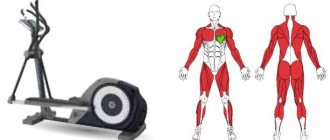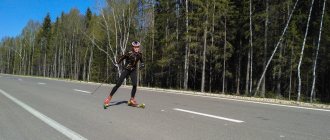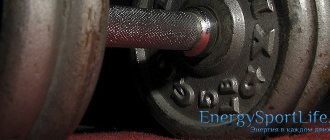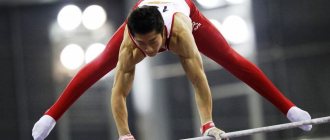What muscles work
The complex nature encourages the development of multiple groups. Of course, not all of them receive the same tone, however, we can say that when we get on skis we work on the following departments:
- Chest and arms. Primarily the trapezius and deltoids, biceps and triceps. This is ensured by support on sticks and injections.
- Back and abdomen. Movements during skating include turns and slight tilts. That is, work on the widest and all groups of the press.
- Legs. Of course, this is still a kind of walk. Works the buttocks, thighs and calves.
- Neck. To a lesser extent, but still in a slight tone, she is also.
Strengthening joints
At first glance, it looks incomprehensible, but the load on the knee and hip joints during skiing is not as strong as when walking. It's all about sliding and additional supports in the form of clubs: the pressure on the spine area and on all groups of joints will be insignificant, the person will take a small number of steps, and the effect of the mass on the leg area is reduced.
That’s why experts advise patients with arthrosis to ski. Overweight people will also be able to engage in this sport without fear.
Ski walking is allowed for patients with arthrosis of the hip joints of 1st and 2nd degree.
If you have problems with your knee joints, orthopedists do not recommend giving up movement. In this way, the condition of the joints can be improved by receiving nutrition from the bloodstream of nearby muscles.
Experts have long noted that practicing this sport stimulates the muscle framework, accelerates metabolism in the joints, preventing their aging.
Skiing, benefits and key advantages
Let’s briefly go through the most important criteria and parameters, why this sport is so loved by millions of people. Why is it considered not only the most effective, but also one of the most convenient workouts?
Availability
Residents of many countries, alas, are deprived of such entertainment due to geographical location and climate. Indeed, somewhere in Egypt such a method of self-improvement will be completely unpopular. Fortunately, our climate often provides up to five months a year suitable for activities. All you need for this is ammunition and equipment.
Strengthening the immune system
Don't forget that there are other benefits besides exercise. This is fresh and cold air. At the same time, it is a way to harden the body and saturate it with oxygen, especially if you exercise in nature. This technique really strengthens the immune system and helps to more easily adapt to the cold and protect against colds - the eternal companion of winter.
Weight loss
We have already reported about a thousand kilocalories per hour during intensive skiing. But, even if you don’t work hard and don’t break a sweat, it’s quite possible to reach 500-600 kilocalories per hour. Therefore, such a system is often chosen by those who want to lose extra pounds, but are not ready for very high loads in the gym. This does not mean that this option is created specifically for the lazy. It just adapts to almost any level of a person’s training, it all depends on the labor involved.
Development of the respiratory system
In addition to the usual work on the diaphragm, in this case we get another great advantage in addition. This is fresh and (preferably clean) air. It develops the respiratory system many times better and promotes a productive effect on functional qualities. Just remember that proper breathing technique is key. Breathe through your nose, at least inhale, and keep your breathing periodic and even.
Benefits for the skeleton, joints and muscles
We have already explained how running and skiing are beneficial specifically for the body. In fact, any vigorous activity leads to the development of bone and muscle tissue. Whether jogging, fitness, or weightlifting. But training does not cause damage to the body, does not put pressure on joints and tendons.
Removal of toxins
Naturally, every time we sweat, through the sweat glands we get rid of a significant amount of waste and toxins, as well as other harmful accumulations. Of course, in order for this action to be as effective as possible, it is better to simultaneously undergo a special dietary course, as well as periodically consume various sorbents, for example, Polysorb.
Preservation of youth
The benefits of skiing for health are clear, but how can they affect the preservation of youth? These are literally air baths, which are very effective for maintaining youth and elasticity of the skin, smoothing out wrinkles. Actually, spending time outdoors is already a very positive influence. Needless to say, if you add light or intense walks here.
Improved psychological state
Why do people love outdoor recreation so much? Such pastime provokes the production of endorphins, hormones of happiness. Therefore, it is preferable to practice any sport outdoors; even professional athletes use this method.
Increased performance
A great way to relieve accumulated stress after work, relax your soul and body, get a charge of mental vigor and prepare for the next day. The health benefits of skiing are complemented by the positive effects on our mind.
Preparing skis: advice from professionals
Universal hydrocarbon waxes
This product category is the most budget-friendly and easiest to use. This type of paraffin can be used in cases where you have to spend a long time skiing, but there is no need to show high skiing results. Paraffin wax is perfect for ski instructors or guides.
Advantages of waxes: excellent water-repellent ability, which ensures that the ski glides quite easily; protection against dirt sticking to sports equipment.
Disadvantages: wax must be frequently applied to the surface of the ski, as it wears off quickly due to its soft structure.
Temperature oriented hydrocarbon waxes
Used by athletes in specific temperature conditions. Paraffins contain special additives that, at a certain snow temperature, activate the action of the wax and ensure better ski glide.
Cold (hard) waxes - used for skiing when the snow is very cold and its temperature on the ski slope is -12 degrees or lower. In conditions where the snow layer is cold and has low humidity, it is important that paraffin has increased wear resistance. It is solid paraffin that is resistant to sharp ice crystals. However, as soon as the temperature of the snow rises and its humidity increases, the skis lose their ability to glide, as the snow simply sticks to the surface of the equipment.
Medium (semi-hard) waxes - used for skiing at snow temperatures from -12 degrees to -2 degrees. They have slightly less hardness, but they repel moisture well, which is necessary in weather conditions when the humidity of the snow is high.
Warm (liquid) waxes are paraffins with a soft consistency, which contain silicone or substances similar in action and characteristics, providing excellent water-repellent ability to skis. Waxes are used at snow temperatures of -2 degrees and above.
Fluorocarbon waxes
This type of paraffin provides high water-repellent properties to skis and guarantees their excellent glide on snow.
low fluoride – used at low snow moisture levels (less than 60%);
medium fluoride - used in cases where the snow humidity is at an average level (from 60% to 80%);
high fluoride – suitable for high levels of snow humidity (more than 80%).
Which paraffin is better
If we talk about the quality of waxes presented on store shelves, then, first of all, it is necessary to take into account their cost.
Some of the cheapest paraffins are fluoride-free waxes. If financial resources are limited, then you can purchase the entire range of such waxes, namely: CH4 (-10...-32), CH6 (-6...-12), LF7 (-2...-8), LF8 (+4...- 1), HF10 (+10…0). Thus, skis can be prepared for skiing at any snow temperature.
The presence of fluorine in paraffin indicates that the wax can be used at high snow temperatures; in addition, the skis are reliably protected from dirt on the piste and glide perfectly on the snow. The cost of such waxes is much higher and the purchase of such products is not always justified or possible.
If the funds are minimal, then you can get by with basic paraffin (there is no marking on it) and treat the surface of the skis only with it.
Where to buy and how much does paraffin for skis cost?
You can purchase waxes in specialized sports stores. As for the cost of the product, it is influenced by several factors: the composition of the wax, the volume of packaging, and the manufacturer.
The price of the most budget brands of domestically produced waxes does not exceed 100 rubles. Paraffins from foreign manufacturers with a high fluorine content can cost in the range from 1,700 rubles to 7,000 rubles.
Some manufacturers offer products for skiing directly in Russia. In addition, you can find products designed for use with artificial snow. The range includes waxes specifically for training athletes.
How to apply paraffin to skis
In this matter, the main thing to remember is that any ski lubricant is better than no lubricant. This is especially true for skis made of wood.
To prepare sports equipment for skating, you will need two types of wax: for sliding and for holding.
For the procedure you need: an iron (if you don’t have a special one, you can use an ordinary household one, but without holes in the sole), a damp cloth, a plastic scraper, a nylon brush, a dry soft cloth.
The first surface treatment of the ski is carried out at a temperature of 65-70 degrees with paraffins that are soft in consistency (fluorine-free).
Using a warm iron, it is necessary to heat the entire surface of the sports equipment or only the heel or toe areas, taking into account what kind of skiing the skis are intended for.
Using a heated iron, touch the prepared paraffin and drip a little onto the surface of the ski.
Using an iron, melt the wax into the surface of the equipment, while constantly ensuring that a layer of paraffin is maintained between the skis and the iron. Leave the ski for 10-15 minutes until the wax completely hardens.
Then you need to remove the paraffin using a scraper and polish with a prepared dry cloth.
Using a similar method, you should treat the remaining sliding surfaces of sports equipment and apply paraffin to the base layer of wax that matches the temperature of the snow. The method for applying weathering wax is similar to the method described.
How to remove paraffin from skis
As soon as the skis begin to lose speed and glide poorly on the snow, you need to think about the fact that it’s time to pay attention to surface treatment of the equipment.
In order to clean the surface of the ski from paraffin, you should use a special remover or scraper.
Washing removes the base layer of paraffin, in which case the wax will have to be applied starting from scratch. If the base layer of wax remains on the surface of the ski, you can subsequently apply paraffin to it, suitable for any weather conditions.
To clean skis you need: a special machine for attaching equipment, a scraper made of organic glass or plastic.
First you need to secure the ski in the machine.
Movements of the scraper are carried out from the nose of the ski to the heel. The scraper should be used evenly without changing the pressure. This will avoid deformation of the ski.
Note: it is important to clean the scraper from excess paraffin and ensure the sharpness of the object. If necessary, sand it with sandpaper.
Particular attention must be paid to processing the edge of the skis and the groove. To do this you will need scrapers of the required shape.
The remaining parts of paraffin must be removed with a stiff brush. Movements should be short.
In order to clean the sliding surface of the ski from adhering dirt or remove all layers of paraffin, including the base one, a hot method is necessary. To do this, you will need a special iron or a household iron without holes in the sole.
Using an iron, you need to apply paraffin to the ski, and before it hardens, treat the surface with a scraper. If the action is performed correctly, a roll of paraffin, dirt and other substances used should form.
Sport is an integral, important part of a healthy and fulfilling life for every person. And the sport associated with skiing is doubly useful, as it allows a person to breathe fresh air and enjoy nature. Have an active holiday, relax with your whole family, friendly groups and live brightly.
To run comfortably with a classic stroke, the skis must glide forward and “hold” back. Unsupportive skis are a torment for a skier. We have already covered this in a separate article. Today we will tell you how to wax skis for a classic move so that there is no “recoil”. The process is very similar to preparing skate skis, but you need to additionally lubricate the holding area.
Where is ski holding ointment applied?
Grip ointment is applied to the skis in the “pad” area . Last - the area under the boot and forward about 30 cm.
This image shows the approximate last length (based on ski length) for beginner skiers.
When selecting a pad, you should not accurately calculate centimeters and strictly follow the instructions. The ideal holding zone is individual for everyone . Start with the recommendations on the diagrams, and then adjust, depending on the glide and grip of the skis.
There is “kickback” on skis - increase the block forward.
Skis glide poorly and slow down with ointment - reduce the block.
Important! Adjust the block only at the front of the ski. At the back, the holding ointment should reach a maximum of the heel of the boot.
Once you find your last length, mark it on your skis with a marker or sticker.
Quick preparation of classic skis
What is needed to prepare skis without an iron and other equipment?
slip ointment for quick application
holding ointment for quick application
In this method, everything is simple: the sliding area is smeared with sliding ointment, the holding area is smeared with holding ointment. We wait 2 minutes and you can ride. Learn more about applying liquid gliding ointments.
The method is very convenient and fast. But it is not as effective as preparing skis with solid ointments. Quick ski preparation is enough for an average of 5 km. If you plan to ski more, then you will need a different way to lubricate your skis.
Preparing classic skis with solid ointments
The principle is the same, but holding ointment is applied under the block, and the sliding area is treated with paraffins using an iron. We wrote how to treat skis with paraffin in the article:.
What is needed to apply the holding ointment?
solid holding ointment
synthetic rubbing
masking tape (preferred, but not required)
100-grit sandpaper (preferably, but not required)
How to apply grip ointment to skis?
It is advisable to treat the block with fine sandpaper under the holding ointment. Ideal with 100 grit. Carry out this operation only when you find a block that suits you. Rough plastic will hold the ointment better and it will last longer.
To make smearing more convenient, you can mark the area of the block with masking tape. This way you will not stain the sliding surface of the ski with grip ointment when you rub the ointment.
The ointment is applied in thin layers, each layer must be rubbed with a synthetic cork. It is better to apply 2-3 thin layers than one thick one. A thick layer of ointment is difficult to spread evenly.
To increase the mileage covered with one application of holding ointment, the primer layer can be applied under the iron. That is, first sand, then fuse a thin layer of ointment with an iron, and then everything is as usual.
This treatment of skis will be enough for 50 km or more. If the weather has changed, then the old ointment must be removed and a new one applied according to the weather.
How to remove old grip ointment from skis?
The old holding ointment is removed with a scraper. To do this, it is better to have a separate scraper so as not to stain the sliding surface with ointment.
After removing the ointment with a scraper, the residues are washed off with special solvents. The procedure is optional, but after 2-3 treatments it is better to completely clean the holding area using washes.
End of form
Anyone who is seriously passionate about speed skiing knows how important timely care of equipment is. To achieve optimal glide, you need to be able to properly prepare your skis.
What factors determine the choice of lubricant?
In order for cross-country skis to be properly prepared, the following factors must be taken into account:
Air temperature . Depending on what value the thermometer shows, manufacturers provide various types of ointments and paraffins. The most common color options for their packaging are:
Red – the ointment is designed for temperatures above 0˚ C,
Blue – ointment is used at sub-zero temperatures,
Purple —lubricant is used in variable weather conditions.
Snow grain structure. Achieving the best glide will be possible by applying a structure to the sliding surface of the skis that fully corresponds to the structure of the snow under certain weather conditions.
Equipment required for preparing skis
When preparing cross-country skis, the following devices are used:
Tables and machines. Used to secure and conveniently hold skis during processing. Their design may include clamps or special fastening “legs”.
Thermal devices. Necessary for heating ointments and paraffins. Usually special irons and hair dryers are used. It is not recommended to use household irons to heat up paraffins - their soles have too high a heating temperature and can lead to the risk of damage to the sliding surface of the skis.
Scrapers. Serve to remove layers of frozen paraffin from a sliding surface. The material of manufacture is plastic or plexiglass.
Cycles. Designed for removing damaged layers of plastic with a fleecy structure from the sliding surface of skis. Used mainly by professionals.
Brushes. With their help, the final finishing of skis is carried out after applying paraffins and lubricants. Rotary brushes (mounted on a rotating axis) can also be used. Use brass and bronze brushes to remove dirt and old paraffin from the surface. A steel brush is used to give the sliding surface the necessary microstructure. Nylon brushes, depending on their hardness, are used to remove old paraffin (the colder the weather, the harder the brush).
Paraffins, pastes, liquid lubricants. Used to impregnate the sliding surface of skis. They differ in the content of fluorine and various additives. The high fluorine content makes the price of paraffin high. For frosty weather, paraffins with a low fluorine content are used, and for warm and humid weather, high-fluoride paraffins are used. Pastes and aerosols, according to manufacturers, can be applied in any weather, but they are applicable for those skis that have already been treated with paraffin. Among the manufacturers of paraffins and lubricants, Swix, ToKo, Rode, Holmenkol, and domestic ones: Luch, MVIS, VISTI have proven themselves well.
Cross-country ski preparation technologies
Depending on the level of the skier and the style of movement (classic or skate), various methods of preparing skis are used. For the amateur level, treating skis with special ointments will be sufficient. For the classics, these will be holding ointments that provide good glide and reduce the “recoil” when pushing.
The rules for selecting ointments recommend taking into account weather conditions and paying attention to the lower temperature limit indicated on the packaging. It should be 2-3 degrees higher than the ambient temperature. Apply ointment to the pad area in 2-3 layers, carefully rubbing each layer with light movements. It is best to do this indoors and allow the skis to cool for 10-15 minutes immediately before skiing. At the end of skating, the remaining ointment must be removed with a scraper and washed with a remover.
Paraffin treatment involves a more complex technology . A special table or machine is required. At the beginning of the preparation, a process of “hot” cleaning occurs, after which they begin to apply paraffin at a certain temperature.
The skis are fixed on a table or machine, a special iron is heated to the minimum melting temperature of paraffin. Molten lubricant is applied to the sliding surface and smoothed out quickly, avoiding delays. Before the paraffin has had time to cool, it is cleaned off using a scraper and a stiff metal brush. The recommended thickness of the molten paraffin layer should be from 0.5 to 1 mm.
When the cleaning stage is completed, they begin to apply paraffin “to suit the weather.” It is applied in the same way as cleaning paraffin, but after application, the skis are removed from the machine and allowed to cool for half an hour. During this time, the lubricant should penetrate deeply into the structure of the sliding surface. Then, using a scraper and a soft nylon brush, remove excess paraffin and bring the surface of the skis to a shine.
Applying paraffin to classic skis eliminates the need to treat the last area.
Ski paraffin is necessary to improve the sliding moment. No matter what kind of skis we ski - classic or skating - without additional lubrication the skis will give too good grip on the snow. But good grip is only needed when the wheels are moving on asphalt. In order to develop speed on a snowy slope, it is better to have minimal grip on the surface. In the case of flat skiing, reducing friction helps to reduce the effort a person makes when moving.
What are paraffins
Paraffins are hydrocarbon mixtures formed as a by-product of petroleum refining. Paraffin compounds have different degrees of viscosity. There are:
soft (liquid) paraffins that melt at room temperature;
solid – melt when heated within 70 ° C;
crystalline - turn into a liquid state at temperatures above 70 ° C.
Functionally, paraffins are, in most cases, lubricating, water-repellent substances. They are added to various mixtures to give the appropriate consistency and properties. For example, Vaseline is made from petroleum hydrocarbons.
Paraffins are used in technical lubricants. These substances have also found their use in skiing as agents that improve the gliding of skis and snowboards.
Ski wax
Ski waxes are traditionally divided into:
lubricants for cold skiing at snow temperatures below -12 ° C;
lubricants for skiing at snow temperatures -12 ° C…-2 ° C;
warm lubricants for snow temperatures above -2 ° C.
The key substance that provides better gliding at high temperatures is fluorine. The less fluorine, the more severe frost (and low humidity) the paraffin is designed for. Conversely, high fluoride greases are designed for mild and wet weather.
There are universal lubricants, the composition of which ensures good gliding on any snow. For example, TOKO Irox Fluoro spray, although low-fluorine, is designed for use in a wide temperature range of 0 ° C...-30 ° C. In addition to fluorine, ski lubricants include: silicone, various salts, oxidized metals.
Using wax on plastic skis
It would seem that plastic is a well-gliding material without lubricants. Unlike, for example, traditional wooden skis, which, due to the low density of the material, provided better grip and, accordingly, rode worse.
The new skis actually glide great. But as you ride, microcracks appear on the sliding surface and edges. Ice and snow particles damage plastic. And although these changes are not noticeable to the human eye, under a microscope the surface of such a ski resembles a mountain landscape. Sliding properties deteriorate due to such a landscape.
In order to fill all these microdamages and restore the perfectly slippery surface of the ski, hydrocarbon lubricants are used.
Why choose liquid paraffins?
It should be noted right away that paraffins in liquid form do not have any advantages over solid waxes in terms of functionality. The purpose of all paraffin waxes is to impregnate the sliding surface of the ski. To ensure the most effective rolling, all waxes, including liquid ones, require heat treatment after application.
Liquid paraffins are available in 2 types:
liniment;
aerosol.
Paraffin in the form of a cream-ointment, in general, from the user’s point of view does not have any differences from solid types.
The aerosol form provides additional convenience in terms of application. True, part of the product is sprayed past, which is why the consumption of paraffin aerosols is always greater.
Application of liquid paraffins
To apply liquid paraffin, the ski must be clean and dry. Particles of dirt, water, ice that become clogged in the micropores of the sliding layer will not allow you to apply paraffin correctly.
With heat treatment
Waxing of skis with heat treatment, as a rule, is carried out during periods between skiing in home-garage conditions. This initially assumes that the skis have been cleaned and dried.
Heat the iron to 150 ° C.
Spray liquid paraffin onto the sliding layer of the ski. We keep in mind that different types of skis require different models of lubricant application. For skating skis, the entire sliding surface is lubricated. Classic skis are waxed, bypassing the central part.
Iron the ski from toe to heel.
Let the ski cool and dry at a temperature not lower than 0 ° C for at least 10 minutes.
We pass the layer with the applied lubricant with a brush.
As a result of these manipulations, heated paraffin penetrates the pores of the plastic, fills them, and the microscopic “landscape” of the sliding surface is leveled. The wax remaining on the surface is excess. We remove it with a brush.
Ideally, this cycle should be repeated up to 10 times. The fact is that brushing, in addition to removing the surface layer, also removes part of the “useful” paraffin that filled the microcracks. When we repeat waxing several times in a row, we better “compact” the uneven skis with paraffin, filling the unevenness and microcracks more efficiently.
No heat treatment
Often we do not have the opportunity to use an iron, we are limited in time, and we need to lubricate our skis because they glide poorly. Manufacturers of liquid paraffins offer the theoretical possibility of using their lubricants without heat treatment.
Drying the ski.
We clean the sliding layer with a brush to remove dust and dirt from the pores of the plastic.
Wipe and let dry a little.
Apply a SMALL layer of lubricant.
Let stand for 3-5 minutes.
We rub it with a cork, a pad or whatever we are used to using.
Let stand for 10 minutes.
If you still put too much lubricant, you should use a brush and remove the excess layer. However, lubricant manufacturers warn that with the cold method of applying paraffin, brushing at the final stage is not significant.
And if it does, it will last no more than 5 minutes. For proper cold lubrication it takes about 1 hour. It is advisable to have sun or some room for drying.
You should be aware that, even if all of the above conditions are met, cold waxing is always an emergency measure, which in its effectiveness can never be compared with the classic heat treatment option.
Cost of liquid paraffins
Paraffins in the form of ointments cost about $5 per 25 g. Sprays, especially high-fluoride ones, can cost up to $40 per 50 ml bottle.
The types of skis do not influence the choice of one or another wax. However, it should be remembered that, unlike skating, the sliding surface of classic skis requires lubrication with additional holding ointment. Since traditional skiing requires pushing off and, accordingly, requires better adhesion of the ski to the snow at the point of application of force, the holding ointment is applied to the center of the ski.
The most popular is skiing. To avoid problems while skiing and to make the movement comfortable, you need to take care of your equipment in advance. There are several options for special ski lubricants that need to be selected individually.
Why lubricate your skis?
This question arises among beginner skiers, since many consider this procedure unnecessary. During driving, a frictional force is created, which depends on the quality of the equipment and the condition of the snow. To reduce it, lubrication is carried out. There is another reason why wooden skis and equipment made from other materials should be lubricated, since the use of ointment prevents slipping back during the push. Thanks to the application of a special product, the middle part of the ski sticks well to the snow. With constant use of lubricants, the service life of equipment can be extended.
Which skis don't need lubrication?
There are different opinions regarding whether preparing equipment is mandatory. If we turn to the competent opinion of specialists, they, discussing whether it is necessary to lubricate skis, say that if you want to enjoy perfect gliding, then it is recommended to carry out a simple lubrication procedure before each walk. In addition, this will allow you to preserve the equipment for a long time.
How can you lubricate skis at home?
In stores and other points of sale you can find many different products designed for ski fans. If a person does not plan to engage in it seriously, then there will be no need to spend money on expensive formulations presented in the form of aerosols or branded paraffins. For those who are interested in how to lubricate their skis for better glide, a wide range of different ointments are offered.
Such products are presented in two types: for better glide and grip. Beginning athletes can use universal kits from well-known brands: Visti, Swix or Briko. All products are color coded according to the temperature at which they must be used. If the temperature is above zero, then liquid formulations are used. For negative values, the following classification applies:
0 to -2 – purple color;
-2 to -8 – blue;
-5 to -12 – light green;
-10 to -25 – dark green;
-15 to -30 – black.
When figuring out how to lubricate skis, you need to pay attention to common paraffins, which, according to their properties, are divided into options for sliding and securing. It is worth knowing how to lubricate your skis so that the snow does not stick in the absence of other means, you can use wax and paraffin from candles, but medical grade is better. There is a widespread belief among people that you can use soap, but in reality it will not do any good.
How to lubricate skis at home?
To care for your own equipment, you don’t need to turn to specialists, because, knowing some of the subtleties, you can carry out all the procedures yourself at home. For those interested in how to properly lubricate skis, you should know that it is important to consider not only the material from which the equipment is made, but also the style of intended riding.
How to lubricate plastic skis?
If such equipment was purchased, then it is necessary to apply lubricant to a clean and dry surface at room temperature. When understanding this, it is worth considering the basic rules:
When using a solid ointment, apply it in several layers, rubbing each of them. After this, leave everything to cool and apply the last layer outdoors.
It is recommended to carry out the test after walking a couple of kilometers, and if necessary, the product should be changed. Those who are interested in why plastic skis need to be lubricated should know that without this, the glide will not be as good.
For classic skating, it is customary to apply paraffin or gliding ointments, but only to the back or front, but the central area is lubricated with holding agents.
When using paraffin, it is applied in drops, leveling them with an iron. After this, it is cooled and removed with a scraper. Finally, treatment is carried out with a nylon brush.
There is another important topic - how to lubricate plastic skis with notches. Such equipment does not require lubrication, but over time the notches wear off and then paraffin should be applied.
How and with what to lubricate semi-plastic skis?
This type of equipment is made of wood, but a plastic plate is applied on top of the sliding surface, which protects against wear. In operation it is the same as for products made of plastic. For those who want to know how to lubricate skis so that there is no kickback, then you should use the recommendations described above for the plastic version.
How to properly lubricate wooden skis?
If you have equipment made of wood, it will be impossible to do without lubricating it, which is applied to a dry and clean surface. First you need to carry out priming, for which paraffin is used and it is better to take a candle-tablet. You need to rub harder, and then run a hot iron on top. Remove any excess that is not absorbed. This procedure should be carried out before each trip to the snow. Instructions on how to wax skis are as follows:
Lay the equipment downside down on a flat surface and clean them with a rag.
Hold the heated iron 2.5 cm above the skis and start processing from the edge. Apply a little wax to the iron itself until it melts and drips. Walk it over the entire surface.
At the bottom, perform back-and-forth movements with light pressure. The resulting layer of wax should harden, and then, using a scraper, remove it, moving from the highest point to the bottom.
An important step in the instructions on how to lubricate wooden skis is to treat the entire surface with a special brush, making only translational movements and applying slight pressure on the tool.
Skis should be taken out into the cold for several hours, and then left overnight at room temperature.
How to lubricate combination skis?
Some manufacturers have created special combination equipment that is suitable for both classic and free style. It is worth noting that you can find them on the market less and less often. To choose an easy way to lubricate your skis, you need to consider what running style will be used in a particular case. Processing schemes will be described below.
How to properly lubricate cross-country skis?
For amateur skiing, you can simply use special ointments that are selected depending on weather conditions. They should be 2-3 degrees higher than the outside temperature. Lubricate the pad area with ointment, applying 2-3 layers, rubbing each layer with light movements. Finally, it is recommended to leave the equipment for 10-15 minutes. cool down. After riding, using a scraper and rinsing, the remaining product must be removed. The diagram on how to lubricate cross-country skis with paraffin is more complex.
First they need to be mounted on a table or machine. At the first stage, the process of “hot” cleaning is carried out.
Using an iron heated to the minimum melting temperature of paraffin, smooth out the melted lubricant. It is important to avoid delays.
Without allowing the paraffin to harden, clean it using a scraper and a stiff brush. The final layer should be 0.5-1 mm.
After this, paraffin is applied taking into account weather conditions. The procedure is similar to the steps described above, and after removing the residue, the skis should cool for half an hour.
Using a scraper or nylon brush, remove remaining paraffin, bringing the surface to a shine.
How to lubricate skis for classic skiing?
Fans of this kind of skating should use slip and grip ointments. The first is usually applied to the sliding surface, and the second to the last (the area in the middle, which is determined from the heel of the shoe plus 15-20 cm). For those interested in how to lubricate skis, you should know the following information:
At the first stages of treatment, cleaning is carried out, and then a gliding ointment is applied.
After this, treat the block with a holder ointment, which must be selected based on the temperature and humidity of the snow.
If it’s warm, then use liquid products, and if it’s cold, then use solid ones. In the second case, a grinding plug is used.
It is important to consider that grip and glide ointments should not be mixed.
After applying the first layer, the product must be given time to set, and only then re-lubrication is carried out.
The preparation is completed by polishing with a nylon brush.
Another important point is how to lubricate skis with paraffin; it is applied only to the ends of the equipment.
How to lubricate skating skis?
Processing equipment for such riding is simpler, since only gliding ointments are used. Not for professionals, one layer of ointment, selected according to air temperature, will be enough. As in the previously described treatment schemes, the surface is cleaned. After this, you can proceed to the instructions, which concern how to properly lubricate skis at home:
First, heat the iron to the temperature indicated on the paraffin wax.
Place the block on the surface of the iron and move it so that the drops of paraffin are evenly distributed.
After this, run the iron from heel to toe to completely melt the wax. A uniform shine will indicate that everything was done correctly.
An important step in the instructions regarding how to lubricate skis with paraffin at home is to remove excess with a scraper after the layer has hardened. Move against the direction of the ride. Finish the procedure with polishing.
How to lubricate skis?
Before going out into the snow, it is necessary to hot-treat the equipment, which will help fill the pores. The procedure for lubricating skis is similar to the options described above. First, dirt and existing unevenness are removed. Be sure to lubricate everything with a degreasing compound. At the next stage, apply the blue ointment hot, and then, after it hardens, remove excess with a scraper. You can also use liquid ointments that are spread with a sponge.
Based on materials from the site gducfkis.ru
Photo: i2.wp.com
How to lose weight and get in shape
For such purposes, we will need primarily the aerobic side of this work. That is, the part of the exercise that makes us breathe. This means that we include the maximum number of movements in the program, but reduce the intensity and level of stress so as not to exhaust ourselves ahead of time.
For example, climbing uphill is for muscle growth, but not for weight loss. But long-distance running, combining different styles and so on is the best option.
It is worth remembering that the benefits and harms of skiing depend entirely on a well-calculated individual plan. You can choose it yourself, using advice from the Internet, or with the help of a professional instructor. Naturally, the second option is preferable.
What you need to know about lubricants
There are two types of ointments for plastic skis - grip and glide. The first ointment is applied to the central part of smooth skis (block), which are designed for classic skiing. This ointment is available in liquid and solid form. It is selected depending on the temperature of the snow. The functions of such a lubricant are similar to those performed by notches - to prevent skis from slipping back when pushing off, so there is no need to apply it to skis with notches, unlike sliding lubricant, which is applied to any type of ski.
Ski slip wax provides, as the name implies, good glide. It is applied to the back and front of a classic ski, regardless of whether the option with or without a notch is chosen. For skating skis, lubricant is applied to the entire surface.
Age restrictions
In fact, there are no restrictions. This is a safe activity for any age group. Many experts insist that children should be instilled with a love for this trend from the age of two. But there is a nuance here. As everyone knows, if you force a child to do something, you can instill in him hatred for this procedure. Therefore, it is best to spend active trips with the whole family.
But already at the age of seven years, the child can be sent to the section. As a result, from an early age we will strengthen the baby’s bone tissue, help to properly develop the skeleton and muscles, and increase tone and immunity.
For whom else is walking suitable? Is skiing good for older people? Undoubtedly yes. But here strict restrictions must be observed. If you have problems with the musculoskeletal system, breathing, or cardiovascular system, then you should include minimal exercise in your daily plan. No amount of physical education will be of any use if you simply do not have enough physical strength to exercise. Therefore, only small doses are acceptable. And, of course, without difficult descents and ascents.
How to go skiing?
There are several important conditions that it is important for beginners to pay attention to.
- You need to choose the right equipment. When choosing skis, important details are taken into account, for example, type of sport, height, and so on.
- In addition, you should buy the right clothes, which should not hinder your movements, but at the same time keep you warm.
- It is necessary to undergo an examination and exclude possible contraindications.
- Beginners should start with minimal loads and be sure to ride on prepared trails. If possible, you should work with a trainer.
- If a person wants to engage professionally, then preparation for skiing should take place in special schools where training programs have been developed.
Preparation
Before you go out to the park and begin the actual execution, you need to start developing a plan, prepare all the equipment, and acquire the right clothes.
Equipment
It is best to purchase a special suit. It is convenient, functional and, no less important, aesthetically pleasing. Bulky jackets and sheepskin coats are not suitable; earflaps are also a thing of the past.
Now there are a lot of excellent technologies that are aimed at maintaining heat during walks, while at the same time not overheating the body. The ideal balance is maintained, which is necessary for the development of the body. But remember that quality is an extremely important parameter. Therefore, many choose expensive foreign brands or find Russian, less expensive, but identical in quality domestic nuggets. The Stayer brand can easily be classified as one of the latter - its suits and jackets are comfortable and wear-resistant, and their ability to keep you warm and dry will allow you to stay outside as long as you want.
Adviсe
- When visiting a public track for the first time, ask regulars about the rules of conduct.
- Take care of your feet, this is the most vulnerable place. New boots have a nasty habit of chafing. We recommend taking a patch and ointments with you.
- If there is no food court nearby, then you should solve the problem yourself, take with you an energy bar and a thermos with an invigorating drink.
- And, of course, if the route runs far from residential areas, always keep first aid equipment, communications equipment, as well as a small camping knife and matches in your backpack.
How can skiing harm the body?
Skiing can not only be beneficial, but also harm the body. This can happen if a completely unprepared or sick person rides.
In particular, you should pay attention to the condition of the blood vessels. If you are diagnosed with varicose veins - unhealthy stretching of blood vessels, then you will no longer be able to ride. Even those who attended training in unsuitable equipment suffer from it (we are talking about buying high-quality compression underwear that prevents pathological stretching of blood vessels).
It is important to know that even after a common cold, at least 10 days must pass.
Beginners should start training with simple sections of terrain, otherwise there will be a high risk of injury. It’s good if everything ends with a few bruises and abrasions. But by neglecting your own safety, you can get sprains, dislocations or fractures of the limbs; the spine and neck area also remains at risk.
Techniques and teaching methods
Actually, there is no point in specializing in only one type. It is quite possible to have good command of both options, alternating them on different sections of the route. And for harmonious development, it is always better to focus on an integrated approach.
Classic
This is a direct move. To perform it, you need to stand strictly straight and level, alternately move your legs, alternating these movements with rearranging the sticks. Every step requires a push. This also includes a full push stroke, when the skier pushes off with both hands at the same time, moving forward, and then repeats the cycle. The feet remain in the same position.
Skate style
This is an angular move that resembles the Latin numeral V. The idea is to alternate legs, while the arms only help with a push at the end. Movements begin from the inside, gradually moving.
This is a simpler and faster method, but it does not require a ski track, but a well-known track along which you can move freely.
Selecting skis by hardness
First of all, when choosing skis, you need to decide on their stiffness, which is very important for driving performance. Skis have a deflection: the greater the force required to ensure that this part of the sliding surface of the skis touches the snowy track, the stiffer the skis are considered. If the sliding surface under the block does not touch the floor, then you need skis of less rigidity. For skating style skis, which are 15-20 centimeters shorter than classic skis, but twice as stiff, allow a gap between the floor and the surface of the skis to be up to 1-2 mm. Some models indicate the range of human weight for which the skis are designed.
Skis of low and medium hardness are more suitable for non-professionals. If you plan to ski on virgin lands where there are no ski tracks, then you need to choose between touring (tourist) and pleasure skis, which are wider than classic skis, therefore, it is easier to lay your own ski track on them.
How to learn to run
In addition to the two styles outlined above, the future conqueror of snowy plains and mountain peaks should learn a couple more mandatory techniques. And only in this case will he be ready for real training in rough terrain.
Ways to overcome climbs
The specific technique depends on many factors. This includes the density of the snow, the temperature outside, the depth of the snow, and, most importantly, the angle of inclination. The steeper it is, the more reliable the method should be used.
You can simply drive up a low slope in a classic way. This is a labor-intensive procedure, but can be performed without problems by an experienced person.
If the climb is steeper, it is better to use a herringbone. This is an alternating step with the same V number.
The steepest hillocks need to be overcome with a ladder. The skier stands sideways and lifts one leg onto the slope, then moves the other towards it in increments of 20-25 centimeters.
Racks of descents
They differ in the depth of the squat. The person's knees should be slightly bent. But, if we talk about a high stand, the tilt is almost invisible. It is used for braking and maximum air resistance.
The mid stance is a deeper lean, ideal for maneuverability and downhill turns.
Well, low is used only in cases where maximum speed is needed.
Types of braking
The main methods are plow and semi-plough. The only difference between them is the number of legs involved. The first is sharp and intense braking, when the toes are brought together and the heels are spread apart. As a result, the stop occurs edgewise.
A half-plow is turning just one foot to slow down smoothly.
Remember - no one ever slows down with the help of sticks.
U-turns in motion
The main method for both professionals and beginners is a wedge. To perform the technique, it is enough to transfer the body weight to the side where we need to turn, bend the leg, bend the shoulder. Inertia itself will turn you around.
Contraindications
The benefits of skiing are now very clear to us, but are there any pitfalls?
Actually, steep slopes, heavy loads and terrain with a lot of obstacles are, in principle, contraindicated for beginners. The main thing is to take on a feasible burden. But there are also medical recommendations.
- Existing injuries;
- Operations of any plan less than six months ago;
- Dysfunction of the musculoskeletal system;
- Joint diseases;
- Spinal injuries or spinal disorders;
- Osteochondrosis, nephroptosis, rheumatism and other related disorders.
Freeride skis
Head of the Fischer Marketing Department Alexander Kaniovsky freeride in Saalbach.
Freeride is skiing or snowboarding outside of prepared trails and, as a rule, outside the service area of the ski industry.
It is believed that it is when skiing on untouched snow that all the capabilities of alpine skiing and snowboarding are most fully revealed. At the same time, off-piste skiing also promises many dangers associated with unfamiliar terrain, for example, the possibility of avalanches. Beginners should not rush to go off-piste in the mountains; to do this, they should have certain skills in riding techniques.
Article on the topic
Freeride skis: history, types and rocker technology









